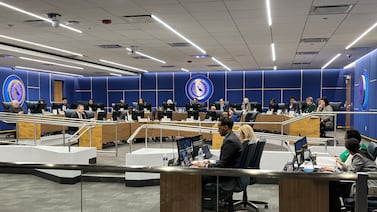Sign up for Chalkbeat Detroit’s free daily newsletter to keep up with the city’s public school system and Michigan education policy.
This month marks the 50th anniversary of the U.S. Supreme Court ruling in a Michigan case that some experts say turned back the clock on efforts to desegregate schools.
The July 25, 1974 decision in the historic Milliken v. Bradley case overturned lower court decisions that would have paved the way for a cross-district busing plan to send thousands of Black Detroit students to suburban schools and thousands of white suburban students to Detroit schools.
The massive integration plan sparked controversy and protests. The nation’s high court rejected the plan, saying that while it was clear Detroit schools were segregated, there was no evidence the dozens of suburban schools that would have been forced to bus students to the city were responsible for the segregation.
It wasn’t the first attempt at integrating Detroit schools. In 1960, the district introduced a plan to bus hundreds of Black students in order to achieve integration. The plan was met with widespread opposition.
A decade later, a new plan was introduced – and launched the court case that ended up before the U.S. Supreme Court.
Here’s a timeline of key dates related to the Milliken v. Bradley court case:
April 7, 1970: The Detroit school board adopted a plan to integrate schools by redrawing school boundaries. It would have meant the busing of 10,000 students so 11 high schools would become more integrated.
Spring, Summer 1970: The Michigan Legislature passed Act 48, which repealed the Detroit district plan to achieve integration. The repeal was led by Coleman Young, a legislator who would go on to become Detroit’s first Black mayor.
In place of the April 7 plan, lawmakers introduced an open enrollment policy that allowed white students in neighborhoods that were transitioning from white to Black to transfer out of Black schools.
Aug. 18, 1970: In opposition to the legislature’s Act 48, the NAACP filed a federal lawsuit against Gov. William Milliken, Attorney General Frank Kelley, State Superintendent John Porter, the State Board of Education, the Detroit school board, and the Detroit superintendent. The NAACP argued that the state had intentionally segregated Detroit’s public schools through its housing policies and should be obligated to desegregate them.
Sept. 27, 1971: After a 41-day trial in the spring and summer, U.S. District Judge Stephen J. Roth ruled that Detroit schools were deliberately segregated. He did not order a specific remedy at this time.
June 14, 1972: Roth issued a massive school busing order that would require hundreds of thousands of children to be bused between Detroit and 53 suburban school districts in order to integrate schools. It was the largest busing order in the nation’s history and the intention was to bus Black students to suburban schools and white students to Detroit.
Roth’s ruling acknowledged two realities: By the time the NAACP lawsuit was assigned to his court, white flight had already dramatically changed the demographics of the district, making it difficult to achieve integration if the order only involved city schools. Second, segregation in schools was influenced by redlining, which was effectively barring Black residents from integrating white communities, and federal and state policies were bolstering segregation.
July 10, 1972: Roth orders the state of Michigan to purchase 295 school buses to aid in the cross-city school busing plan designed to achieve integration.
Dec. 8, 1972: Roth’s order was upheld in Cincinnati by a three-judge panel of the U.S. Court of Appeals for the Sixth Circuit. The ruling paved the way for an appeal to the U.S. Supreme Court. The appeals court ruling came months later than expected, preventing Roth’s order from going into effect for the 1972-73 school year.
July 11, 1974: Just two weeks before the historic U.S. Supreme Court decision, Roth died of a heart attack. He was 66.
July 25, 1974: The U.S. Supreme Court ruled in the Milliken v. Bradley case that the lower courts used erroneous standards in its order requiring cross-city busing. In the 5-4 ruling, SCOTUS agreed that Detroit schools were segregated. But the court’s majority said there was no “showing of significant violation by the 53 outlying school districts and no evidence of any interdistrict violation or effect.” The court further ordered the case remanded for further proceedings “leading to prompt formulation of a decree directed to eliminating the segregation found to exist in Detroit city schools, a remedy which has been delayed since 1970.”
Aug. 16, 1975: U.S. District Judge Robert E. DeMascio rejected two desegregation proposals — one from the Detroit school board and the other from the NAACP — that would have involved a fair amount of busing. He ordered the board to come up with a plan that would involve less busing.
Jan. 26, 1976: This was the first day of busing under a DeMascio order and reports were that the day was peaceful. Attendance was down substantially, though. And DeMascio’s order only affected about 10% of the district population and left “vast stretches of the predominantly black inner city virtually untouched.”
Lori Higgins is the bureau chief for Chalkbeat Detroit. You can reach her at lhiggins@chalkbeat.org.






